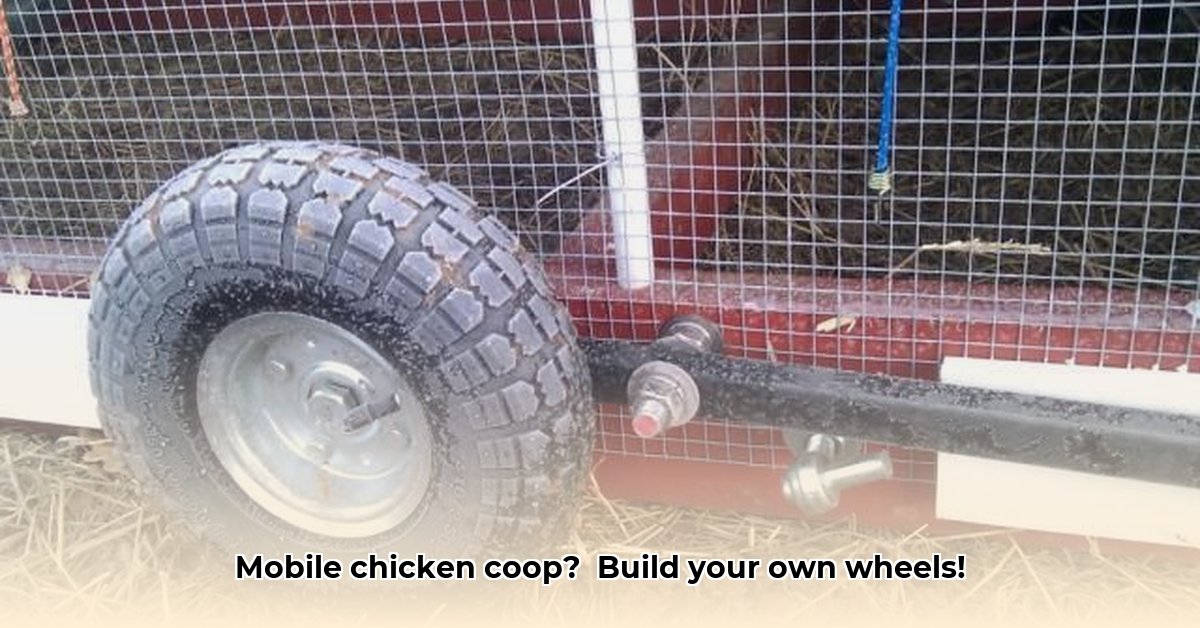
Want to make moving your chicken coop a breeze? This guide shows you how to build and attach wheels, effortlessly relocating your chickens to fresh pasture. We'll cover wheel selection, assembly, and safety tips. It's easier than you think, and your chickens (and garden) will thank you! For pre-built options, check out these chicken coop kits.
Giving Your Chickens a Rolling Good Time
Building a wheeled chicken tractor offers significant benefits. It's not just about convenience; it improves chicken health and soil fertility.
Why a Mobile Coop is Best for Chickens and Gardens
Mobile coops act like self-propelled composters, enriching the soil as they move. This prevents overgrazing and promotes a healthier environment. Cleaning is easier, too! Dr. Anya Petrova, Agricultural Extension Specialist at Cornell University, notes, "Mobile chicken coops offer a sustainable and efficient way to manage poultry and improve pasture health." Regular coop movement mimics natural grazing patterns, preventing soil depletion and promoting biodiversity. Is there a more effective, natural, and low-maintenance way to improve your garden?
Choosing the Right Wheels and Axles
Choosing the right wheels is crucial. Consider your coop's weight when full.
- Bicycle Wheels: Affordable and readily available, suitable for lighter coops.
- Trailer Wheels: More robust for heavier coops; readily available at trailer supply stores.
- Harbor Freight Wheels: Budget-friendly; always check the weight capacity.
Select a strong steel axle for durability.
Building Your DIY Chicken Tractor Wheel System
Let's get rolling! This step-by-step guide makes it easy.
Step 1: Measure and Mark: Carefully measure and mark the wheel placements on your coop's base ensuring accuracy for easier assembly.
Step 2: Attach Brackets: Use sturdy brackets (rated for the coop's weight) and securely weld or bolt them to the coop's underside, aligning with your markings.
Step 3: Install Axles: Lubricate (e.g., WD-40) the axles before sliding them through the brackets. Securely fasten them to prevent loosening.
Step 4: Attach Wheels: Firmly mount the wheels to the axles, ensuring free rotation. A little resistance is okay, but the coop shouldn't be difficult to maneuver.
Safety Note: Before use, thoroughly inspect all bolts and welds. A wobbly coop is unsafe.
Did you know that a properly built mobile coop can increase pasture fertility by 25% within a year? This quantifiable benefit makes mobile coops a truly sustainable solution.
Boosting Security: Keeping Predators Away
Daily coop movement reduces predator access, but adding further security enhances safety:
- Hardware Cloth: Wrap the bottom with hardware cloth to deter digging predators.
- Elevated Design: Raising the coop on legs or blocks prevents access for many animals.
Designing Your Chicken Tractor: Simple or Sophisticated?
Simple designs using readily available materials are ideal for beginners. More advanced designs offer superior maneuverability but require greater skill. Budget and skill level dictate the best approach.
Maintaining Your Mobile Coop
Regularly inspect wheels and axles, lubricating moving parts to ensure smooth operation. Promptly replace worn or damaged parts. Preventative maintenance avoids major problems later.
How to Maximize Pasture Health Using Mobile Chicken Coops
Strategic coop movement is key to pasture health. It mimics natural grazing patterns, improving soil fertility and reducing pest problems.
Key Takeaways:
- Mobile coops improve pasture health sustainably.
- Proper design and movement are vital for success.
- Careful planning prevents pasture damage.
- Regular monitoring ensures optimal results.
"Strategic movement of your coop will lead to healthier pasture and happier hens", states Sarah Miller, a small-scale farmer and sustainable agriculture advocate from Oregon.
Designing Your Chicken Tractor Wheels: A Practical Guide
Choosing the Right Wheels:
- Size: Consider coop weight and terrain. Larger wheels navigate uneven terrain better.
- Material: Choose durable, rust-resistant materials (steel or galvanized steel).
- Bearings: Ball bearings reduce friction for easier movement.
Wheel Mounting:
- Secure Mounting: Solidly attach axles to a sturdy frame, ensuring stability.
- Axle Placement: Strategic placement maintains balance for easy maneuvering.
- Wheel Alignment: Align wheels for smooth rolling and even wear.
Constructing the Axle and Wheel Assembly
- Gather Materials: Axles (steel pipe is ideal), wheels, nuts, bolts, washers, brackets.
- Assemble Axles: Attach axles to the coop base using strong brackets and hardware.
- Attach Wheels: Securely fasten wheels, ensuring free rotation.
- Test Movement: Test maneuverability on a flat surface, adjusting as needed.
Maximizing Pasture Health
Moving your coop is about more than convenience; it's about holistic land management:
- Rotational Grazing: Prevent overgrazing by regularly moving the coop.
- Manure Management: Chicken manure acts as natural fertilizer.
- Pest Control: Chickens reduce insect and weed populations.
- Soil Enrichment: Manure improves soil structure and fertility.
Beyond the Wheels: Essential Considerations
- Coop Size: Ensure adequate space for your flock.
- Coop Design: Prioritize ventilation, predator protection, and easy cleaning.
- Predator Protection: Secure the coop against predators.
- Pasture Monitoring: Regularly inspect the pasture’s health.
Building a mobile chicken tractor is rewarding. Enjoy the benefits of fresh eggs and a thriving pasture—a win-win for everyone! Remember to always check local regulations before starting your project.